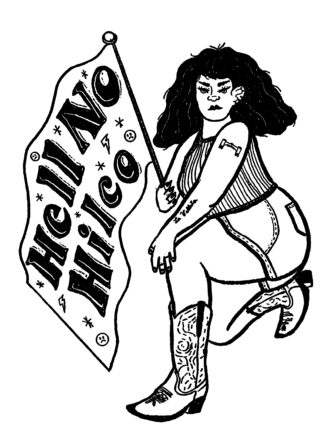
Elizabeth Cardona
In this coloring page depicting environmental injustice, an octopus represents industries that are redeveloping properties. A corn plant and butterflies represent the community fighting for environmental justice. Image: Elizabeth Cardona
By Brianna M. Lane
Chicago artists are explaining environmental justice efforts to their community through coloring books.
The books allow people to engage with a serious subject like environmental justice, said William Estrada, one of the leaders of the project for the Chicago ACT Collective. It introduces and deepens their knowledge on topics like diesel fuel and its effect on the air.
The bilingual interactive coloring book, Just Transition Volume 1, showcases Little Village’s vision of a transition that prioritizes employees, children and the planet’s well-being over pockets, said Edith Tovar, who also leads the project and works for the Little Village Environmental Justice Organization.
Submissions came from community artists, community members and people with a connection to Little Village. The goal is to have the coloring books available within the next two months, Estrada said.

Claudia Rangel
A girl hugs a house that reads, “Take care of our community.” Image: Claudia Rangel
Little Village, La Villita, is a predominantly Mexican American neighborhood on Chicago’s west side. The neighborhood’s two-mile stretch of local businesses along 26th street bring in Chicago’s second-highest gross revenue, The Chicago Sun-Times reported.
But still, it experiences environmental injustice.
Brownfields, air pollution, contaminated land and high diesel truck traffic trouble the neighborhood, Tovar said.
The Chicago ACT Collective and the Little Village Environmental Justice Organization lead the project. The Little Village Environmental Justice Organization is a non-profit organization that aims to achieve environmental justice for the community.
The Chicago ACT Collective was started to support grassroots movements through art making, Estrada said.
“We also wanted to know how we could as artists, educators and activists use art as a tool to inform the people most affected by it,” he said.
Submissions had to reflect one of the five prompts:
- Images that make Little Village Special to them
- A contrast between current industrial land use, environmental sustainability and culturally relevant industries or businesses
- A just transition from brownfield sites to clean green spaces
- Community members pushing back on city processes that don’t include their voices
- Community members during the COVID-19 pandemic and the creation of mutual aid networks
Each coloring page will have a slogan from a list that was provided. Coloring pages will either have a Spanish and English slogan on the same page or a separate Spanish and English version.
Limited edition coloring books will be sold to help fund the free coloring books. There is no price yet for the limited-edition version. The free coloring books will be distributed in Little Village with crayons.

Sarita Garcia
A woman kneels with a banner opposing the redevelopment of a local coal power plant. Image: Sarita Garcia
The project grew from the Little Village Environmental Justice Organization’s environmental awareness campaign, “Hell No Hilco,” Tovar said. The campaign raises awareness of the negative health and environmental effects of Hilco Redevelopment Partners repurposing the Crawford Coal Power Plant into a warehouse.
It also shines light on the lack of community involvement in decision-making by Hilco and the city, Tovar said. We want to ensure the community isn’t exploited or endangered and a space is created for the benefit of the community.
“We just want a seat at the table,” she said.
Originally the property was promised to the community and was going to be transformed into something by and for the community, she said.
In April, a Crawford Coal Power Plant smokestack was demolished, Block Club Chicago reported. The demolition left a cloud of dust over the neighborhood.
Residents received short notice.
Hilco posted a notification less than 48 hours before the demolition and The Chicago Department of Transportation issued a street closure notification less than 24 hours before, Block Club Chicago reported.
“We have used art making as a way for us to heal, as a way for us to celebrate our existence and to claim our spaces. It’s also used as a way to organize,” Estrada said.
